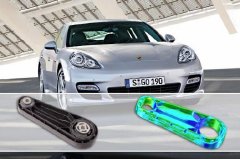Sustainable solutions for lightweight vehicles that also fulfill aesthetic requirements: this is what today's automakers are looking for. ContiTech Vibration Control, internationally successful manufacturer of engine mounts for the automotive industry and BASF have joint forces to create such solutions.
 Installed at two suspension points lengthwise, the stabilizer in the Porsche Panamera not only fulfills the function of securely mounting the engine, but also satisfies the demanding requirements for an appearance part with an aesthetically appealing surface in the engine compartment. With this in mind, the injection mold was optimized at ContiTech Vibration Control to achieve a fine, matte surface texture. The unique plastic component made of Ultramid® A3WG7 CR replaces a comparable component made of metal: By employing BASF’s ULTRASIM™ simulation package, it was possible to design the component as a production part directly on the computer and without a prototype phase.
Installed at two suspension points lengthwise, the stabilizer in the Porsche Panamera not only fulfills the function of securely mounting the engine, but also satisfies the demanding requirements for an appearance part with an aesthetically appealing surface in the engine compartment. With this in mind, the injection mold was optimized at ContiTech Vibration Control to achieve a fine, matte surface texture. The unique plastic component made of Ultramid® A3WG7 CR replaces a comparable component made of metal: By employing BASF’s ULTRASIM™ simulation package, it was possible to design the component as a production part directly on the computer and without a prototype phase.
The result is an innovative stabilizer for the new Porsche Panamera. The high-performance integrated component is made of a high-strength polyamide from the Ultramid CR family and a functionally optimized NR+ natural rubber mixture. It reliably withstands engine torques up to 650 Nm while providing very good sound absorption and secure mounting of the engine in the vehicle. Compared to a metal component with comparable functionality, the sports car manufacturer is able to achieve a weight savings of 35 percent.
Requirement: Permanence and esthetics
With a power of up to 500 HP, the Panamera is the Porsche among the four-doored Premium-Gran Turismo. Such high-performance vehicles present special challenges when it comes to engine mounts. For this innovative automobile, Porsche selected an equally novel material solution. Since the stabilizer is visible when the hood is open, ContiTech Vibration Control worked in close cooperation with Porsche's design department to give it a visually appealing textured surface.
"The stabilizer has to bear high loads but must also work as a visible part and therefore has to fulfill aesthetic requirements. ContiTech Vibration Control thus built a special mold for the part to achieve an optically high-quality surface", explains Stefan Wöhler, responsible for product development at ContiTech Vibration Control.
No prototypes: Developed on the computer from concept to series
From the very beginning, the component was designed almost entirely on the computer in BASF's polyamide Ultramid with the aid of BASF's universally applicable ULTRASIM simulation package. "As material specialists and development partner BASF thus supports its customers with a field-tested simulation technology that includes numerous newly developed elements", comments Bernhard Aumer, ULTRASIM expert from BASF's Engineering Plastics.
The challenge was to satisfy the criteria for a certain functionality and load-bearing capability within specified spatial constraints. After a few iterations, BASF had a component concept that ContiTech Vibration Control, the system supplier responsible for the entire integrated elastomeric mount, was able to convert directly into a construction near to series quality. No additional testing of prototypes was required and optimization cycles were reduced to a minimum, which translates into enormous time and cost savings in automobile development. Test bench trials at ContiTech Vibration Control and vehicle trials at Porsche confirmed the results.